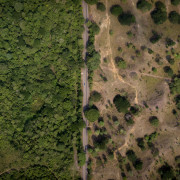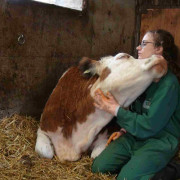- Science News
- Featured news
- Can lions coexist with cattle in Africa?
Can lions coexist with cattle in Africa?
by Laurence G Frank/Deborah Pirchner, Frontiers science writer

Image: Shutterstock
Protecting lions and the interests of cattle producers in Kenya is a difficult balancing act. In a recent Frontiers in Ecology and Evolution article, Dr Laurence G Frank, a researcher at the Museum of Vertebrate Zoology at the University of California, Berkeley, and the Mpala Research Centre in Laikipia, Kenya, explored how protecting livestock can help protect endangered lions. As part of our Frontiers Scientist series, Frank, who also is the director of Living With Lions, a conservation research group working in nonprotected areas of Kenya to save the remaining wild lions and other predators outside National Parks, caught up with Frontiers to tell us about his career and research.
What inspired you to become a researcher?
All children love animals and some who never grow up become zoologists. At the age of 10 I was introduced to field biology at a local community museum, where we were taught basic ecology and animal behavior, collecting and specimen preparation technique, and formal field note format. My weekends were spent pestering local reptiles and trapping small mammals in the Bay Area hills; many of my juvenile specimens are in the California Academy of Sciences research collection. A field course on east African mammals at the age of 18 hooked me on Africa and I returned to Kenya a few years later to study pesticides in raptors. After an MSc in ecology at the University of Aberdeen, I did my PhD at Berkeley, studying the social behavior of spotted hyenas in Kenya’s Masai Mara National Reserve. With Prof Stephen Glickman, I helped create the Berkeley Hyena Project – a large research colony in the hills overlooking San Francisco Bay – to study the unique biology of female masculinization in this species.

Frank and Steven Ekwanga affixing a GPS collar to a lion in a study of their impact on the highly endangered Grevy's zebra. Image: Dr Margaret Kinnaird
Can you tell us about the research you’re currently working on?
After 20 years of hyena research, in 1997 I turned to the conservation biology of lions, creating three projects in different parts of Kenya with two basic remits: helping traditional pastoralists (herding peoples) and modern ranchers better protect their cattle from lion predation, and understanding how lions adapt their behavior to avoid being killed by people angered at losing livestock to predators. Those were carried out by PhD and MSc students from Kenyan, American, and British universities, as well as dozens of Maasai warriors and colleagues from a variety of universities. I am partially retired now but am still active in Laikipia.
In your opinion, why is your research important?
Lions are one of the most iconic of animals but, like all African wildlife, are rapidly disappearing under the pressures of a burgeoning human population. National parks are critical to conservation, but most are too small and too far apart to protect wide-ranging animals like elephants and lions, which move beyond the boundaries of parks, create problems for humans, and are then killed in retaliation. If these species are to persist, viable breeding populations must be maintained in the human-dominated landscapes between parks, requiring coexistence, however uneasy, between people and problematic wildlife. For large carnivores like lions, tigers, hyenas, and wolves, this requires managing both livestock and predators to minimize predation on livestock and subsequent retaliatory killing. It also means managing humans’ ancient antipathy towards these animals, which are threats to livelihoods and occasionally to human lives. Of course, it also means maintaining healthy populations of wild prey such as zebra, giraffes, buffalo, and smaller grazers, without which lions would have only livestock to prey upon. Conserving lions and other large carnivores necessarily means conserving their habitat and all the wildlife it supports.
An aggrieved cattle owner need only sprinkle a dollar’s worth of pesticide on the carcass and a whole pride is dead in the morning.
Laurence G Frank
Are there any common misconceptions about this area of research?
There are two major misconceptions among the western public: Firstly, that parks are all we need in order to protect lions and other African wildlife, and secondly that the primary threats are disease, climate change, and trophy hunting. Disease may affect individuals but only in rare exceptions threaten entire local populations, let alone entire species. The climate crisis threatens much of life on Earth, but other human impacts are much more immediate. Trophy hunting removes individuals – primarily older males – but is a minor factor compared to pervasive killing by local people to protect livestock. The widespread use of cheap and lethal agricultural pesticides has devastated lion and hyena populations in much of Africa. Because lions return to a kill to feed again the following night, an aggrieved cattle owner need only sprinkle a dollar’s worth of pesticide on the carcass and a whole pride is dead in the morning. Scavengers drawn to a carcass also die: vultures were ubiquitous until very recently but have nearly disappeared from much of Africa in this century due to poisoning targeted at lions and hyenas.
Download original article (pdf)
How would you address them?
Large carnivores are difficult neighbors if one’s livelihood depends on livestock production. African pastoralists perceive little benefit from tolerating lions or expending time, effort, and money to protect their cattle if they can solve the problem permanently with a handful of poison. As most remaining lion range is also occupied by people and their domestic animals, to promote coexistence conservationists must help pastoralists reduce cattle losses while also ensuring that wildlife improves rather than harms their economic and emotional wellbeing. Tourism is central to the latter but few tourist dollars reach the family whose favorite cow was eaten by lions last night. Moreover, much of lion range consists of hot, scrubby bushlands, unattractive for tourism.
What are some of the areas of research you’d like to see tackled in the years ahead?
Making lions and other wildlife worth tolerating is one of the great challenges to preserving wildlife in the developing world and will require much greater western investment than is spent today. Finding ways to promote tolerance of wildlife where impoverished people have more urgent immediate concerns will be key in stemming the wave of extinction sweeping the world today.
How has open science benefited the reach and impact of your research?
Our Living with Lions program in the Amboseli region of Kenya produced the highly successful Lion Guardians project, which employs uneducated Maasai warriors, most of them former lion killers, as citizen scientists, helping their communities avoid livestock losses to predators and working alongside professional biologists in collecting data on lion numbers and ecology. Covering a vast region on foot, the Guardians turned around a rapidly dwindling lion population and produced invaluable data on persecuted lions which are nocturnal, secretive, and very hard to study with standard wildlife research methods. In Laikipia, most ranchers have invested heavily in new methods to protect their cattle from predators, building ‘lion-proof’ nighttime bomas (corrals) of moveable steel fencing rather than local thorn bush, and today very few lions are killed after taking livestock.
Innovations such as the Lion Guardians project and the lion-proof mobile bomas invented by a Laikipia rancher are too important to hide in academic publications, which are expensive and often inaccessible to the public and practicing conservationists. The current extinction crisis is progressing with terrifying speed. All advances in finding effective measures to protect dwindling species must be made readily available to everyone working to protect life on Earth. Frontiers is at the forefront in the movement to put progress in science and conservation ahead of profits.
If you have recently published your research with Frontiers and believe you have a story to tell, then you might feature as part of our new Frontier Scientists series! Send an email with the subject line ‘Frontier Scientists’ and your name to press@frontiersin.org, as well as details on what your most recent research was about.







